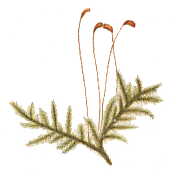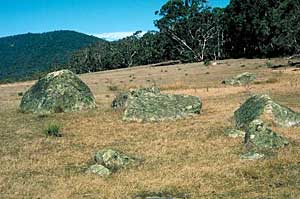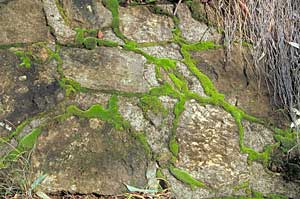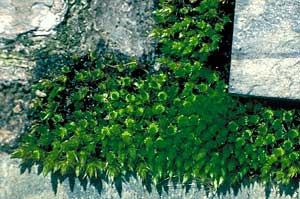
Ecology - Habitats
Micro-habitats
Often, when people speak of habitats they are thinking on a relatively large scale. People talk of habitats such as deserts, coniferous forests, sclerophyll forests, grasslands, bogs, alpine peaks and so on. Such broad habitats are important when talking of bryophyte habitats. However it is equally important to think on a smaller scale at the same time. To a bryophyte a shift of as little as a centimetre may mean a shift to dramatically different conditions where, perhaps, survival is not possible. If a shift of a few centimetres means a shift to a different set of conditions, that also means a shift to a different micro-habitat. When looking for bryophytes in the field it is important to be aware of micro-habitats and realize that sometimes, while taking just a few paces, you may have crossed a dozen different micro-habitats.
 |
Consider the boulders shown in this photo. Such boulders are fairly common in many farm paddocks and natural grasslands and, almost invariably, you'll see a mix of lichens and bryophytes growing on them. The bryophytes growing on these boulders are different to the bryophytes growing on the surrounding soil. From a bryophyte perspective the boulder differs from the surrounding soil. It has a different texture and a different chemistry. Whereas the grasses (and occasional shrubs) of the surrounding area give some shade to the soil, the boulders have no shading grasses or shrubs. The soil soaks up water, the boulders don't. Each boulder is an example of a micro-habitat since it is quite different to the surrounding area. The boulders also heat up more quickly than the surrounding soil and hold that heat longer. The photo shows a scene in Namadgi National Park in the Australian Capital Territory. For at least a part of each winter the grassy area will be under snow and at many other times of the year there will be morning frost in this valley. The larger boulders, at least, will either be above the ground level cold air layer or they would warm up before the soil does. That means that any overnight frost on the boulders will be thawed into water that can be used by the boulder bryophytes while the soil bryophytes are still frozen and dormant. When it rains some of the rain falling on a boulder will be absorbed by the bryophytes or lichens growing on it but often there will also be some runoff. The soil around a boulder will be moister than that further away since the area near the boulder receives direct rainfall as well as runoff. During heavy rain the additional water from runoff will not make a great difference but during light rain the runoff can make a large difference, even dominating the direct rainfall in the immediate vicinity of the boulder. That is especially so when boulders are large and very broad in relation to height. That shape provides a large "catchment" area and the potential for substantial runoff. In arid, low-rainfall areas you will often see richer bryophyte growths in the micro-habitats immediately around the bases of such boulders. Of course, around a boulder that's taller than broad the ground on different sides gets different levels of shading during sunny days, creating yet further soil micro-habitats.
This photo ![]() shows Hypnum cupressiforme growing on Norfolk Island. This is a common, cosmopolitan moss that can be found on soil, rocks or tree trunks. In the photograph you can see a dense layer of fallen Araucaria branchlets carpeting the forest floor. Litter layers on tropical forest floors are generally not ideal for bryophyte establishment. The litter may decay too quickly to allow more than very limited bryophyte growth and, as there is a regular litter fall, any bryophytes that begin to grow are likely to be covered by further litter fall and then die through lack of light. In the illustrated case the Hypnum has colonised some raised wood (either a large piece of dead wood, or possibly part of a buttress root). This micro-habitat has the advantage of being free of litter fall (since any branchlets landing on the protruding wood are very likely to fall off). The moss has made good use of this micro-habitat and, now well-established there, shows some marginal growth onto the branchlet layer.
shows Hypnum cupressiforme growing on Norfolk Island. This is a common, cosmopolitan moss that can be found on soil, rocks or tree trunks. In the photograph you can see a dense layer of fallen Araucaria branchlets carpeting the forest floor. Litter layers on tropical forest floors are generally not ideal for bryophyte establishment. The litter may decay too quickly to allow more than very limited bryophyte growth and, as there is a regular litter fall, any bryophytes that begin to grow are likely to be covered by further litter fall and then die through lack of light. In the illustrated case the Hypnum has colonised some raised wood (either a large piece of dead wood, or possibly part of a buttress root). This micro-habitat has the advantage of being free of litter fall (since any branchlets landing on the protruding wood are very likely to fall off). The moss has made good use of this micro-habitat and, now well-established there, shows some marginal growth onto the branchlet layer.
 |
In the cases illustrated above there are very clear differences – between the rocky surfaces and the soil or between the litter-strewn forest floor and the solid woody protuberance on which the Hypnum is growing. The photo (right) shows part of a rock wall in the Australian National Botanic Gardens in Canberra. You can see a good growth of moss, but that growth is in lines, rather than as spread-out colonies over the rock surface. Incidentally, the green of the moss may look fairly uniform but there are three species, in three different genera, growing here: Gemmabryum dichotomum, Grimmia laevigata and Tortula muralis. You can see the same phenomenon on many brick walls, mosses growing in lines – along the mortar joins. Why are these mosses growing in lines?
There are some bryophytes that will only ever be found on alkaline substrates. A rock-inhabiting species that requires alkalinity could be found on an alkaline rock such as limestone, but never on an acidic rock (such as basalt, for example), You could also find such a species on soil, but only on alkaline soil. You might find the same species in an urban area on surfaces such as concrete walls or concrete roof tiles, since concrete is also alkaline. So you could also find them in the mortar joins between non-alkaline rocks or bricks – but not on those rocks or bricks themselves.
But alkalinity is not necessarily the only possible explanation. Another feature of mortar is that it is rough. Propagules such as spores or gemmae can be caught relatively easily there. A propagule that lands on a smooth surface is easily dislodged. A rough mortar surface will also hold water longer than the surrounding smoother brick or rock surfaces, so providing better germination conditions. So mosses that can tolerate alkalinity, without necessarily being alkaline-dependent, are more likely to establish in the rough mortar lines. Of course, sometimes you'll find mosses growing on the bricks as well. Bricks are rarely totally smooth over their entire surfaces. Tiny pits or cracks are almost inevitable during the firing of the bricks in the kiln. Such pits or cracks can trap propagules and water and so also provide suitable micro-habitats for the establishment of bryophytes. This brief discussion of alkaline mortar vs non-alkaline rock or brick and smooth vs. rough illustrates the importance of micro-habitats and the difference that a shift of just a centimetre or two can make.
Another question you'd have to ask is this: Is this moss growing on the mortar itself or is it growing on soil that has accumulated in the mortar join? Mortar or soil over mortar – two different micro-habitats. You can see the same thing on boulders. While some bryophytes will grow on the bare rock others, on closer examination, are clearly growing on soil that has been trapped in a crack or depression in the rock surface.
Once established a bryophyte colony may spread to the surrounding area that was not suitable for establishment. The earlier case of the Norfolk IslandHypnum spreading onto Araucaria branchlets is an example of this. An established, well-anchored plant may, first, put out branches over the neighbouring area and then rhizoids, that can anchor that branch. In that way the plant may be able to spread into an area where establishment via propagules is impossible.
Spot the Micro-habitats
If you stop in a forest or woodland ![]() and look around, you may see many micro-habitats within a metre or two of where you're standing. The differences over a couple of metres may be meaningless to many vascular plants, but are often very significant to bryophytes. When working with bryophytes it is essential to be aware of such micro-habitats. So, what do you see as you look around? Near your left foot there's a slight depression, just a centimetre or two lower than the general surface level, but enough to hold water a little longer than the surrounding area. By your right foot there's a small soil mound, from which water would run off fairly quickly. Then there's the small rock pile over there (with numerous nooks and crannies) right next to a rough-barked eucalypt. Behind the eucalypt, the hard, fissured bark of the Acacia has a quite different texture. And of course you can see shade at the bases of the scattered grass tussocks, one of which is sheltering a weathered wombat skull. Between the tussocks there are patches of soil, some totally exposed others with a light cover of fallen leaves and twigs. You turn around because you've caught a weak smoke smell. Ah yes, there had been a fire a few weeks ago and there's a heavily charred, fallen trunk and some ash on the surrounding soil. Within that scene there are more than twenty micro-habitats. Some have been explicitly listed, others are implied. For example, looking at the charred trunk the upper surface is different to the sides, and one side will be different to the other in terms of exposure to sunlight. There will be some species that you find in a wide variety of micro-habitats, while others will inhabit only a small range of micro-habitats.
and look around, you may see many micro-habitats within a metre or two of where you're standing. The differences over a couple of metres may be meaningless to many vascular plants, but are often very significant to bryophytes. When working with bryophytes it is essential to be aware of such micro-habitats. So, what do you see as you look around? Near your left foot there's a slight depression, just a centimetre or two lower than the general surface level, but enough to hold water a little longer than the surrounding area. By your right foot there's a small soil mound, from which water would run off fairly quickly. Then there's the small rock pile over there (with numerous nooks and crannies) right next to a rough-barked eucalypt. Behind the eucalypt, the hard, fissured bark of the Acacia has a quite different texture. And of course you can see shade at the bases of the scattered grass tussocks, one of which is sheltering a weathered wombat skull. Between the tussocks there are patches of soil, some totally exposed others with a light cover of fallen leaves and twigs. You turn around because you've caught a weak smoke smell. Ah yes, there had been a fire a few weeks ago and there's a heavily charred, fallen trunk and some ash on the surrounding soil. Within that scene there are more than twenty micro-habitats. Some have been explicitly listed, others are implied. For example, looking at the charred trunk the upper surface is different to the sides, and one side will be different to the other in terms of exposure to sunlight. There will be some species that you find in a wide variety of micro-habitats, while others will inhabit only a small range of micro-habitats.
On the subject of micro-habitats created by grass tussocks, here's an interesting SPANISH GRASS CASE STUDY. There can be different micro-habitats even under the one grass tussock.
You can also play the "Spot the Micro-habitat" game in town. You're walking along a gently-sloping, tiled footpath in a suburban park and stop to drink from a water fountain that's mounted atop a brick pillar. You can see that whenever anyone drinks from here there's some runoff, but only along a narrow line, down one side of the pillar. You're about to walk on but a sudden downpour surprises you, so you run for shelter to a small, covered picnic area not too far away. While waiting for the rain to stop you see that there's an eroded, dirt path between the shelter and the water fountain, quite a contrast to the surrounding lawn, in parts quite green, especially around the in-ground sprinklers. Once the rain has stopped you continue walking, taking care not to trip where a tree root has raised some tiles. There are also a few cracked tiles. Looking further along the path you see that it is acting as a channel, carrying runoff rainwater and so concentrating a lot of water at a spot further along. You stop to read a bronze commemorative plaque mounted on a wall made from a mixture of rocks. The wall runs north-south, so one side gets the morning sun and the other the afternoon sun. The trees and shrubs look quite different after that brief shower. Your walk has now taken you to the end of the path and it's time to go home. You wait to cross a road. Once there's a break in the traffic you step off the concrete kerb, not even noticing the narrow gap between the concrete gutter and the bitumen road. How many micro-habitats have you passed during your walk?
Here's a photo ![]() taken beside Anzac Parade in Canberra. It shows a tiled area near one of the monuments along that road. The black lens cap is five centimetres in diameter. The photo (right) shows a closer view of the moss Gemmabryum dichotomum growing in the cracks between pavers. That micro-habitat is more sheltered than the smooth tile surface and holds water, providing a suitable establishment spot for spores or gemmae. This moss produces gemmae in abundance. The brighter yellow-green "collars" are in fact masses of gemmae. This species is also one of the mosses growing on the rock wall that featured earlier on this page.
taken beside Anzac Parade in Canberra. It shows a tiled area near one of the monuments along that road. The black lens cap is five centimetres in diameter. The photo (right) shows a closer view of the moss Gemmabryum dichotomum growing in the cracks between pavers. That micro-habitat is more sheltered than the smooth tile surface and holds water, providing a suitable establishment spot for spores or gemmae. This moss produces gemmae in abundance. The brighter yellow-green "collars" are in fact masses of gemmae. This species is also one of the mosses growing on the rock wall that featured earlier on this page.
![An Australian Government Initiative [logo]](/images/austgovt_brown_90px.gif)


